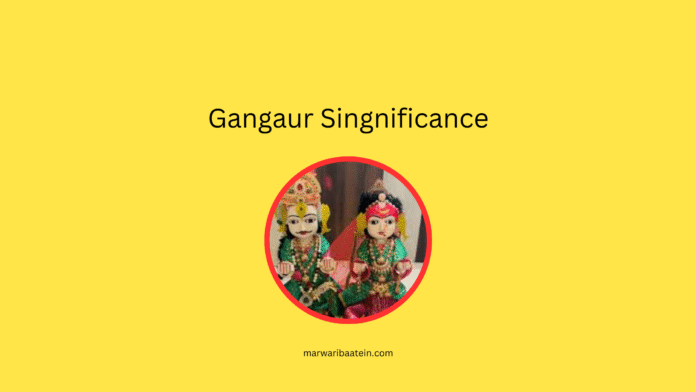If Holi is about color and Diwali about light, then Gangaur is where grace lives — in the sway of sarees, the rhythm of folk songs, and the devotion of women honoring goddess Gauri, the epitome of love and strength.
For every Marwari woman, Gangaur isn’t just a festival. It’s a feeling — deeply personal, proudly traditional, and passed from mothers to daughters like an heirloom embroidered in rituals.
🪔 What is Gangaur?
“Gana” refers to Lord Shiva, and “Gaur” is a fond name for Parvati — the goddess of marriage, fertility, and harmony.
Gangaur celebrates their divine union, and by extension, the strength and beauty of womanhood.
It’s one of the most loved festivals among Marwaris, especially in Rajasthan, and is observed mainly by women — both married and unmarried.
- Married women pray for a long, prosperous life for their husbands.
- Unmarried girls seek a loving, strong life partner, just like Gauri found in Shiva.
📅 When is Gangaur Celebrated?
Gangaur begins the day after Holi and continues for 16 days in the Hindu month of Chaitra (March–April). The final day is the grand farewell procession of Gauri.
In cities like Jaipur, Udaipur, and Jodhpur, the streets come alive with vibrant processions, decked-up idols, and traditional performances.
🎨 Rituals That Make Gangaur Special
🪷 1. Isar & Gauri Murtis
Women lovingly sculpt clay or wooden idols of Gauri and Isar (Shiva), decorate them with clothes, jewelry, and flowers — often passed down for generations.
🌿 2. Daily Puja
Every morning, women:
- Draw traditional mehendi-style patterns on the walls
- Decorate their puja space
- Offer green grass (durva), flowers, and homemade sweets
- Carry out small rituals with song and prayer, often with folk songs echoing stories of Gauri’s devotion
✋ 3. Mehendi & Dress-Up
Applying mehendi (henna) is a must during Gangaur. Women wear their finest sarees, lehengas, borlas, and bangles — especially on the final day.
🎁 4. Sindhara Gifts
Often during Gangaur, parents send ‘Sindhara’ (gifts) to married daughters — including clothes, cosmetics, sweets, and love. It’s a celebration of her role as a daughter and a wife.
💃 The Final Day – Gangaur Visarjan
The 16th day is bittersweet.
The beautifully adorned idols of Gauri and Isar are carried out in a joyous farewell procession. Women sing, dance, and say goodbye to the goddess — wishing her return next year.
In cities like Jaipur, you’ll witness royal processions with elephants, chariots, and folk artists, while in smaller towns, women carry idols on their heads, walking through their neighborhoods with grace and pride.
It’s a celebration filled with music, faith, and emotion.
🧡 Why Gangaur Still Matters Today
In today’s fast-paced world, Gangaur reminds us to pause and cherish:
- The power of feminine devotion
- The importance of tradition rooted in nature and rhythm
- The bond of sisterhood, as women gather daily, laugh, sing, and support one another
- And most importantly — the beauty of hope and intention in love
Whether you’re in a bustling city or a quiet village, Gangaur gives every woman a moment to reconnect — with herself, her relationships, and her culture.
So this Gangaur, wear your brightest lehnga, sing an old folk song, and whisper your wishes to Gauri.
Because somewhere, she’s listening — and smiling.

